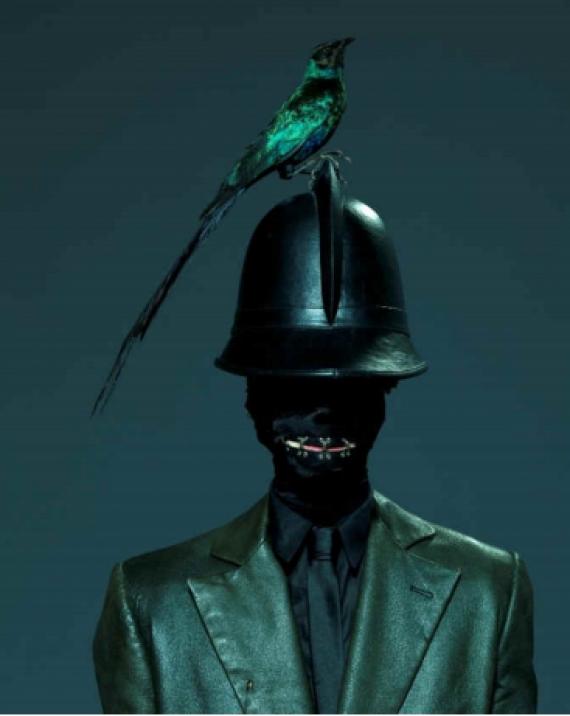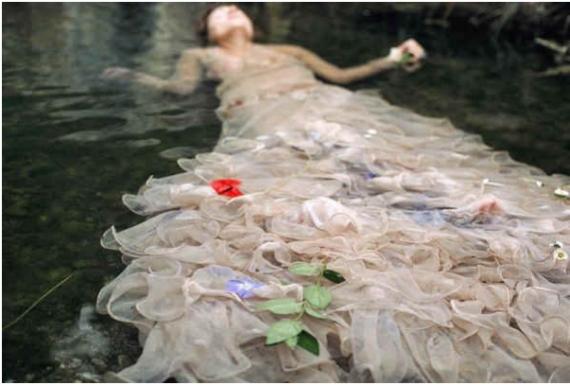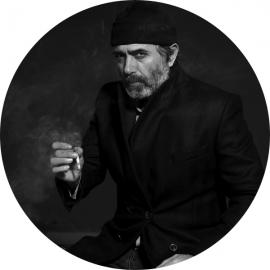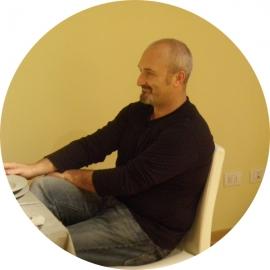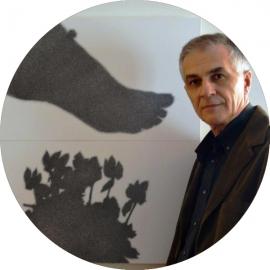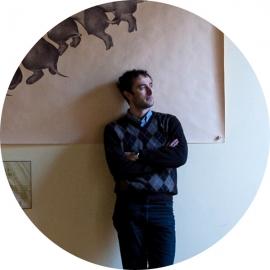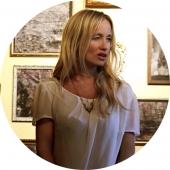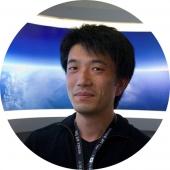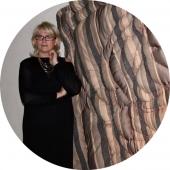maurizio camerani and ketty tagliatti
man ray and stefano bombardieri
erik binder, marcello cinque
simone lucietti e lamberto teotino
WORKSHOP CON MUSTAFA SABBAGH.
IL PAESAGGIO QUOTIDIANO. TRA RITRATTO E LANDSCAPE
DOVE: Ferrara, MLB Maria Livia Brunelli home gallery
QUANDO: sab. 8 ottobre 2016 dalle 10 alle 18
dom. 9 ottobre 2016 dalle 10 alle 18
INFO ISCRIZIONI: This email address is being protected from spambots. You need JavaScript enabled to view it. – 346 7953757
PARTECIPANTI: numero chiuso, massimo 12 partecipanti
Il workshop, tenuto dal noto artista e fotografo italo-palestinese Mustafa Sabbagh, che ha tenuto
di recente con grande successo una Masterclass al MAXXI di Roma, alternerà teoria e pratica,
assoli e coro. Ecco come lo stesso Sabbagh racconta quello che intende proporre nel corso del
workshop.
“Durante la mattina del primo giorno parlerò ai partecipanti della diversità di linguaggi insita nella
fotografia, di come il linguaggio della costruzione di immagini, così composito, possa diventare
mezzo e fine, modus e obiettivo, facendo di tanto in tanto riferimento a quanti in me hanno
lasciato un solco dal punto di vista iconografico, educativo, immaginifico. Nel pomeriggio metterò
in atto le parole, occupandomi della progettazione e della realizzazione di ritratti, all’interno dei
quali obiettivo principale sarà la dimostrazione pratica che il contesto crea la sostanza, che it is my
daily mood that makes the weather, attraverso l’alleanza e la complicità di ciò che maggiormente,
in un ritratto, parla del soggetto: lo stile.
Nel secondo giorno, chiederò ai partecipanti la realizzazione estemporanea di un ritratto
rappresentativo sia del proprio stile – dal punto di vista della tecnica - che dello stile conferito, o
colto, nel soggetto – dal punto di vista della visione; al termine di questa fase, e a partire dai
ritratti realizzati, domanderò ai partecipanti quale sia l’interpretazione dei loro stessi scatti, e da lì
avvieremo un panel di discussione che farà ulteriore luce sulla fotografia, sulla tecnica del ritratto,
ma soprattutto su loro stessi - perché padroneggiare la fotografia, e soprattutto la tecnica del
ritratto, significa obbligatoriamente dovere avere a che fare con se stessi...la lente fotografica è
uno specchio”.
Workshop con Silvia Camporesi. Fare Arte.
Creatività e progettualità nella fotografia contemporanea
DOVE: Ferrara, MLB Maria Livia Brunelli home gallery
QUANDO: sab. 19 novembre 2011 dalle 10 alle 18
dom. 20 novembre 2011 dalle 10 alle 18
INFO ISCRIZIONI: This email address is being protected from spambots. You need JavaScript enabled to view it. – 346 7953757
PARTECIPANTI: numero chiuso, massimo 12 partecipanti
Come nascono le idee? Come passo dal pensiero al lavoro finito – sia esso una singola immagine o
un intero progetto? Di cosa ho bisogno?
Questo workshop è improntato sul tema della progettazione artistica fotografica e riflette su come
muoversi nell’intricata strada dei pensieri e delle azioni che conducono alla realizzazione
dell’opera.
Obiettivo del workshop è comprendere il modus operandi che sta dietro ogni lavoro artistico.Ogni
passo è fondamentale nella creazione di un’opera. Le strade percorse per arrivare al risultato
finale, pur rimanendo nella maggior parte dei casi sotterranee, sono anch’esse parti importanti
dell’opera. Durante il workshop cercheremo di rendere visibili questi percorsi.
1. COME NASCONO LE IDEE
Il primo passo sta nel capire come nascono le idee artistiche, quale il luogo e la suggestione della
loro origine (un libro, la scena di un film, qualcosa visto per strada).
Dopo una presentazione personale, in questa prima parte del workshop guarderemo esempi
importanti di costruzione di opere presi dalla storia dell’arte e della fotografia.
2. LA PRATICA ARTISTICA
Inizio della pratica.
Si partirà da uno stimolo comune che permetterà al gruppo di lavorare su un’idea, per mettere a
punto il metodo di lavoro. Successivamente ognuno lavorerà individualmente sviluppando un
proprio progetto personale.
3. LA STRADA ARTISTICA
Il terzo passo è la preparazione della strada per arrivare al progetto: come passo dal pensiero al
lavoro finito (sia esso una singola immagine o un intero progetto)?
In questa parte del workshop il lavoro consiste nella costruzione di quaderni nei quali raccogliere
pensieri e immagini preparatorie.
L’obiettivo è disporre di tutto il materiale necessario alla realizzazione dell’opera attraverso:
– suggerimenti di idee già esistenti: ricerca tematica su internet, libri ecc. Tutto quello che è già
stato fatto in proposito. Ricerca capillare. Stampa e confronto delle immagini.
– personalizzazione, tramite disegno o costruzione dell’immagine/progetto
– abbinare testi e parole. Impreziosire l’idea rendendola più forte. Eventuale aggiunta di disegni o
tutto quello che serve per migliorare la comprensione dell’idea.
4. COSA MANCA?
Ultimi dettagli da definire nella pre-produzione dell’opera:
– elenco materiale necessario | – luogo | – luce | – altre considerazioni
Il quadro per la produzione di un’opera è completo, manca solo l’atto finale, lo scatto.
Silvia Camporesi è nata nel 1973 a Forlì, dove vive e lavora.
Si è laureata in filosofia presso l'Università di Bologna e oggi è una delle più apprezzate e originali artiste
italiane che privilegiano l'utilizzo del mezzo fotografico.
Affianca l'attività artistica all'insegnamento di fotografia e critica dell'immagine.Ha realizzato molti progetti,
pubblicato, esposto in numerose mostre (www.silviacamporesi.it).
Italo-palestinian, former assistant of Richard Avedon and teacher at Central Saint Martins College of Art and Design in London, after a successful career as a fashion photographer recognized by the most prestigious magazines of the world, Mustafa Sabbagh focuses his research towards contemporary art through the mediums of photography and video-art, by a kind of aesthetic counter-canon in which punctum is the skin as diary of individual’s uniqueness.
Harmony of imperfection, psychological inquiry and anthropological research through the construction of the image are the stylistic features that Sabbagh moves with ease from the glossy pages, to the white cubes of the world's most famous museums and galleries - including the Musée de l'Élisée in Lausanne, considered as an international temple of contemporary photography.
Often protagonist of interviews and documentaries inquiring into his work, to date, Mustafa Sabbagh has been recognized by a photography historian the likes of Peter Weiermair as one of the 100 most influential photographers in the world, and one of the 40 most important nude portraitists - the only one from Italy, on an international basis.
His works are included in several internationally accredited publications (including Faces - the 70 most beautiful photography portraits of all time), in sold-out monographs (among which About Skin - ed. Damiani) and in many private and public permanent collections, both in Italy and abroad (here including the historical Farnesina Art Collection, the ArteFiera Foundation, and the acquisition of one of his unedited projects by the permanent contemporary art collection of MAXXI, Rome).
He’s now displaying an anthology exhibition “Mustafa Sabbagh. XI comandamento: non dimenticare” at ZAC Zisa Contemporary Art Zone in Palermo, 2000 mq in a former industrial hangar: 75 milestone photos form his past works, 10 videos and 3 site specific video installations, and the project acquired by the MAXXI museum, is presented for the first time.
Stefano Bombardieri is born in Brescia in 1968. He learned artistic techniques from his sculptor father, and experimented with various materials. This helped him to acquire a great knowledge on material and technique. His initial approach on sculpture was figurative, influenced by great masters of 1900s. Subsequently his studies evolved into a more philosophical orientation on art, based mainly on the concepts of “time and its perception” and “to experience pain in western cultures”. His works begin from the reality and reaches to imagination of fantastic universes and interior worlds. Besides from his hyper-realistic works, his expressions are related to arte povera, minimalism, video-installations and conceptual works.
Beginning from the 90s, he creates works of great dimensions for public and private spaces. He works between Italy, France and Germany.
He participated to the 52th Biennale di Venezia in the Pavilion of Syrian Arab Republic with his work “Europa Pallida Madre”, installed next to the Chiostro di San Francesco della Vigna, recreates the Column and the Lion of the St. Mark’s square.
Maurizio Camerani (Ferrara, 1951), graduated in Sculpture at Bologna’s Accademia di Belle Arti e Dams, lives and works in Ferrara. He started off as a video artist, handling electronic art and realising sculptures made up by solar panels. He achieved international fame thanks to the important video art fairs he has taken part, such as Montreal’s in 1984 and Locarno’s and Cologne’s in 1985. He exhibited at the XII Quadriennale Nazionale D’Arte (1996) and during “La coscienza luccicante” (2001) at Rome’s Palazzo delle Esposizioni. What emerges in his works, through ritual and alchemic forms, are the energies hidden in human soul. His education as a video artist makes him perceive the video as a warm medium and sculpture as a cool medium. These both are means of expression that, in some of his works, Camerani uses synergistically. An example could be the piece Altrove (2008), shown at the MLB Home Gallery in conjunction with the exhibition Joan Mirò. La terra, occurred at Ferrara’s Palazzo dei Diamanti: Camerani’s great overturned equilibrist made by clay, on whose feet is placed a video showing an hypnotic dance that starts from ground but is pointed to the sky, recalls a reflection concerning the eternal succession of life and death that can be observed in the work of the Catalan artist. The latest installations the artist realised are associated through a consideration concerning the theme of humankind roots and the necessity of a universal spirituality, felt as the one and only safety net in a world characterized by precariousness.
Marcello Carrà is born in Ferrara in 1976. He studied Civil Engineering at the University of Ferrara. He is an artist specialized in drawing with Bic pen in great dimensions (some as long as 8 metres): he surprises with his extraordinary ability of drawing, which is matched with a strong conceptual aspect imprinted on the transience of life, the absolute proximity of death, on fragility and beauty of this existence, which is also evident in the plaques that accompany the works. All of his works are realized by freehand, using solely a grid. He initially focused on the theme of insects and their ephemeral, and at the same time fascinating, existence. Hereafter, always using the pen technique, created another series of drawings with the theme of transience of existence of sows and pigs, then, thanks to the collaboration with a marine biologist from New Caledonia, a series of works that reflect on the dangers that human activity is driving in the tropical marine life. Recently, Carrà revisited several masterpieces by great artists in history: From Brueghel, reinterpreted in the light of the earthquake in 2012; to Zurbaran and Bosch, with his metaphorical reflections on the moral crisis of our age.
He exhibited in the Gallery Antonio Nardone in Brussels, at the Biennale di Venezia, at ArteFiera in Bologna, at MLB home gallery, Museo di Storia Naturale, Museo Casa Ludovico Ariosto in Ferrara, Broni in Bologna and Villa Nuova Italia in Milan.
More...
Stefano Scheda is born in Faenza in 1957. He now lives in Bologna and teaches “strategy of invention” at the Fine Arts Academy. In his works, he has always tried to capture the short-circuit of reality without altering the objective aspects, while leaving space for different perceptions of gaze as well. For this reason, his series: “inside out” or “double gaze” are to examine the threshold as a two-faced contemporary of a gaze. The presence of the sea is consistent in many of his works. His most recent work is realized through a dynamic ductility that speculates over the perception of reality and its possible translation, where the viewer faces difficulties to distinguish between illusion and reality, as in the series of buildings where the doors and windows were replaced with mirrors, creating a sense of alienation in the spectator.
He took part in the several international exhibitions, including Mart di Rovereto (2011), la Biennale di Venezia (2005), GAM di Bologna (2004) and Annina Nosei Gallery in New York (2003). Among many others, Peter Weiermair, Peter Weibel, Jonathan Turner, Emmanuel Cooper, Laura Cherubini, Claudio Marra, Luigi Meneghelli, Roberto Daolio, Ludovico Pratesi, Eugenio Viola, Valerio Dehò, Angela Madesani, Cristiano Seganfreddo, Sabrina Zannier, Daniele Capra and Martina Cavallarin wrote about him.
Dacia Manto's (Milan, 1973) work has fluvial and marshland territories, residues of plain woodlands, marginal and semi-wild areas in its center. Her works are examples of precarious and spatial architecture, structural and poetic observers over the nature, witnesses of nature's elusiveness. She exhibited at important museums; Pav - Torino, MAR - Ravenna, MART - Rovereto, la Galleria Civica -Trento, Pecci - Prato, PAC - Milano, La Strozzina - Firenze, Musée - Saint-Etienne, and in 2013 she made an Arte Pubblica project for Tusciaelecta.
Hiroyuki Masuyama’s (Tsukuba, 1968) variously sized light-boxes are not simply photographic reproductions of the paintings and watercolours of William Turner. They are instead a conceptual operation on the work of this great English artist. Their subject is the works undertaken by Turner during his first journey from London to Venice. Masuyama has followed each stage of this journey and made visual notes, but in a different medium: in the place of sketches he has used photography. But just like Turner, who brought these graphic notes and reminders back to England in order to re-elaborate them in his studio, so too Masuyama has brought the images he captured back to his studio in Düsseldorf and submitted them to a complex operation of montage. The images of his journey and those of the paintings by Turner have thus become in the luminous work of this forty-something Japanese artist a harmoniousunicum in which the limits of space-time have been overcome.
Ketty Tagliatti, born in Ferrara in 1955, graduated from the Fine Arts Academy of Bologna. Between 1992 and 2002 the artist collaborated with the Gallery Studio la Città di Verona, where she began to participate international art fairs. Her studies began with reflections on informal art, which have been the basis for all her works, then she created series dedicated to “chairs” and “roses”. She began her “roses” series in 2003 using various techniques, including embroidery on canvas. The series dedicated to earth and the cultivation of roses, begins when the artist moved to her studio at the countryside, in province of Ferrara. For the artist, each work is like a diary page, where the rituals, slowness and patience play a crucial role. As it is visible in the great tapestry of nearly three meters, entitled Sur-natural: this time the subject is not the artist’s favourite object, a rose, but a camellia, Chinese decorative symbol that the artist made from an old Parisian upholstery at the beginning of the century. The technique used in this very big work is amazing: each one of the rose petals is realized with hundreds of pins, which, wisely accompanied and directed, create soft swirls, which is typical for this flower. The dense texture of shiny pins look like a fine silver embroidery, surrounded by a decorative frame. Nowadays, her studies are shifting towards a more informal and abstract matrix.

